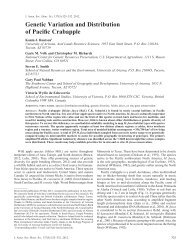CONSERVATION
Conservation You Can Taste - The Southwest Center - University of ...
Conservation You Can Taste - The Southwest Center - University of ...
- No tags were found...
You also want an ePaper? Increase the reach of your titles
YUMPU automatically turns print PDFs into web optimized ePapers that Google loves.
supply chain and catalyze new innovations within<br />
Arizona’s emerging local food community. One<br />
of them was Chris Schmidt, Conservation Director<br />
at Native Seeds/SEARCH, and the other was Gary<br />
Nabhan, who hard learned much from elderly<br />
farmers while helping them sow the seeds of White<br />
Sonora behind draft animals in traditional floodwater<br />
fields in the borderlands. They were both mentored<br />
by Glenn Roberts and food anthropologist Maribel<br />
Alvarez, who had studied White Sonora in Mexico.<br />
When the incipient collaboration began in<br />
Arizona in late 2010, it turned for guidance to<br />
Glenn Roberts of Anson Mills, Stephen Jones of<br />
Washington State University’s Kneading Conference<br />
and Monica Spiller, a historian of heritage grains in<br />
California. Monica had assisted farmers Sally Fox and<br />
Judith Redmond to evaluate White Sonora and soon<br />
Thirsty Bear Brewery in San Francisco elaborated a<br />
fine wheat beer from the harvest that Judith helped<br />
manage at Full Belly Farms. Inspired by other heritage<br />
grain initiatives, just three growers in Arizona initially<br />
sowed White Sonora seed on less than twenty acres<br />
but, by 2013, both the acreage and the number of<br />
farmers had increased.<br />
Emma and her father are still the only artisanal<br />
millers in the state of Arizona but they have built a<br />
strong cadre of collaborators. “This year we had five<br />
farmers growing White Sonora wheat on a total of<br />
66 acres and about 30 chefs and bakers using our<br />
White Sonora flour. It’s great to have so many different<br />
farmers growing because they all try different methods,<br />
unique soil profiles and plant at different times. This<br />
means that collectively we are learning a lot about<br />
growing heritage grains, which we are learning is very<br />
21



